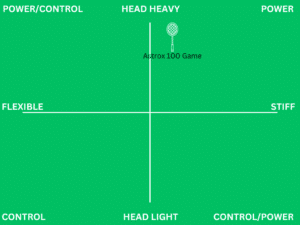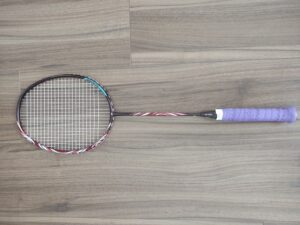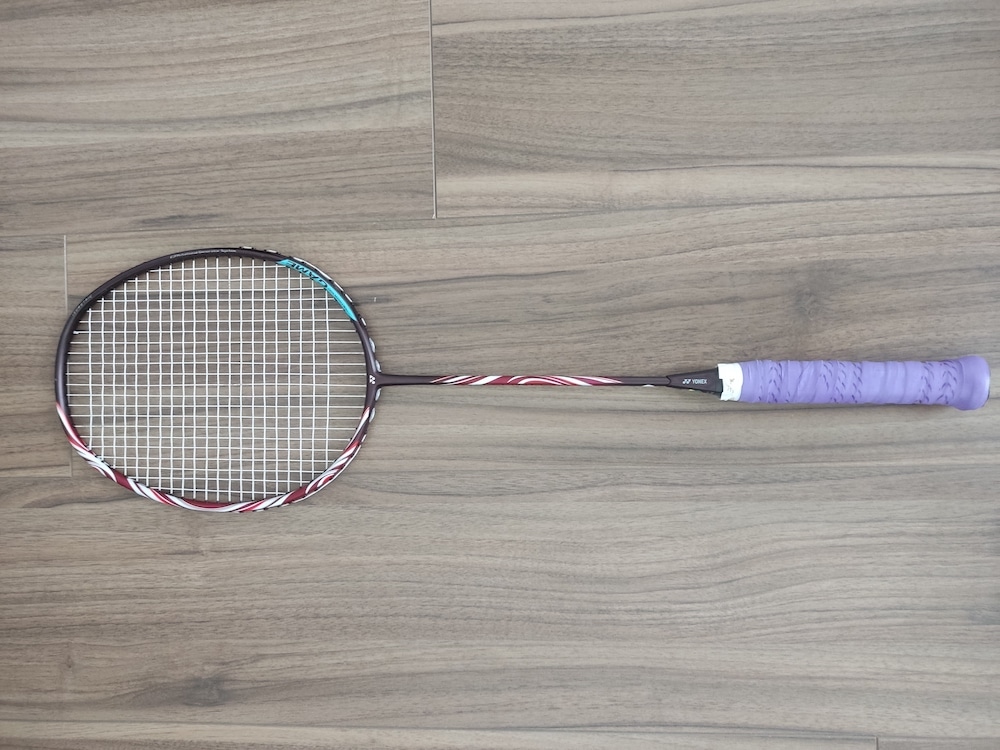
The Yonex Astrox 100 Game is the wallet- and human-friendly version of Viktor Axelsen’s preferred racket at the time of writing this, the Astrox 100ZZ.
The Astrox 100 Game is intended as a racket for the intermediate player who loves power and wants as much of it as possible. It currently carries the most head weight of all Yonex’s rackets for that skill level. The more expensive Astrox 100 Tour and 100ZZ are stiffer and intended for more skilled players.

As I was buying this racket, I was excited to see if I could tame it as the Tour and ZZ are much stiffer and likely out of my league. As a fan of Axelsen’s work, I was also curious to play with it as I felt it would give me a slightly better understanding of how he approaches his game.
Before playing, I immediately got it restrung with my standard Yonex BG80 string and 10-10.5KG tension to keep my experience consistent, and better compare with the other rackets I tested. For reference, that string is a power (repulsion) string.
Knowing that this racket is so powerful, I was concerned about using that string as I figured it might make my game one-sided, like a one-trick pony with only a power smash in my arsenal.
Table of Contents
The Yonex Astrox 100 Game review

I’ve been playing with the racket for about fifteen hours on court and I’m writing this review with beginner and intermediate players in mind. I’ve been testing the 4U model of the Astrox 100 Game, so I can’t speak to the 3U version.
The first thing I noticed playing with this racket was how easy it was to block attacking shots and get them back over the net. I used to play with a power-based, slightly stiff 3U racket from Decathlon’s Perfly brand, and I loved it. I was concerned about getting elbow problems which is why I switched to the 4U weight class and with the Astrox 100 Game, that familiar feeling was back.
I’ve found that those “power” blocks often come at the exchange of a slow swing but that didn’t feel like the case here. If someone sent a rocket at me, I could simply put the racket on and the shuttle would crawl over the net to cause my opponent trouble.
It didn’t require much work and the 100 Game was faster through the air, meaning it was easier to be ready for another incoming smash if I had just blocked one. Keep in mind that this racket obviously doesn’t slice through the air like a head-light racket–you and I are looking at a sledgehammer here.
This racket suited my power-based playing style better than the less head-heavy Yonex Astrox 77 Play I tested, where I felt more in control but often found myself missing 5-10 cm for the shuttle to crawl over the net, and I had to adjust my style.
Playing with the Astrox 100 Game, when I was late to just about any shot, it often felt as if I could just put the racket on the shuttle and it would bounce back over the net nicely. For a casual player like me without crazy stamina, that meant I could have a lot of fun without needing to be perfectly positioned all the time as long as I didn’t try anything crazy or take too many chances.
Flat drive exchanges felt easy, I had no problem keeping up with a high pace and generating plenty of power to surprise the opponent, even when things got intense.
Lifts, as I expected, were easy.
I mean EEEEAZY! Like bouncing on a trampoline-easy.
It felt like I barely had to touch the shuttle when I wanted to lift it to the backline with good power. Even when I felt tired and was late to the shuttle or I had to tackle a tight net shot that required extra height.
Clears and getting out of trouble felt easy too. Late flat shots or “semi-drops” (often with the backhand), when you’re late in the back court, were nice and suited my skills and playing style well.
When it comes to power, this racket has a lot. I mean a lot.
Power play and smashing were smooth. Several players that I randomly paired up with during games commented on the power I was able to produce in my smash, which often meant the opponents weren’t able to control the block and sent the shuttle flying sideways out of the court (and my skills aren’t that good).
However, the 100 Game isn’t all unicorns and roses. The more I played with it, the more I noticed challenges in other areas of the game.
Tight net shots were hard to control and I found myself offering my opponents a relatively easy net kill during net duels more often than I wanted to.
For example, if you’re late to a cross drop and want to send a cross net shot back, it’s easy to get the shuttle over the net. But I found it hard to contain the power, so it was almost too easy to send it 15 cm (5-6 inches) too high and offer an easy point to a quick opponent.
I noticed having the same challenge when playing midcourt to midcourt with the intention to confuse the opponents in doubles games, for example on the return of serve. It was far too easy to add a tad too much power so the shuttle would fly in an arc instead of flat, and give the opponent extra time to return it, which ruined my advantage.
Overall, besides when you’re smashing, playing with the Yonex Astrox 100 Game felt as though using this racket came down to controlling the power and holding yourself back from going all out, rather than working to extract it. That means you’ll need to pay extra attention to how far up you’re standing on the court, as the wrong stroke will easily send the shuttle out of the court and straight toward Mars.
It’s not surprising with this style of racket and I bet that a different string can help contain the power.
In conclusion, I found the Astrox 100 Game to be a terrific racket for the intermediate player who enjoys power or wants to add extra power to their game. However, I’m not convinced it’s flexible enough for beginner players.
Hey reader, a quick interruption... I’m experimenting partnering with webshops that sell badminton gear, like Amazon. I’ll include links to buy the gear I review and if you do, they’ll pay me a small commission. That doesn’t change your price and you’ll get more play-tested gear as a result but I thought it was fair to let you know. As an Amazon Associate, I earn from qualifying purchases. I appreciate your support, Aske
Astrox 100 Game Specifications
| Flex | Medium |
| Balance Point | Head Heavy |
| Weight / Grip | 3U G4, G5, G64U G5, G6 |
Recommended strings
| Yonex’s recommended strings | Control Players: AEROBITE BOOST Hard Hitters: BG66 FORCE |
Yonex Astrox 100 Game: the verdict

Summary
The Astrox 100 Game is a great value for money-racket considering that it only costs about a third of the top model.
It’s a particular style of racket that isn’t for everyone. It’s very strong in power but hard to control on nimble shots around the net.
The best player types for Yonex Astrox 100 Game
Let’s look at who this racket is good for and who should steer clear of it.
The ideal player type
This racket is well-suited for intermediate players who like attacking and don’t expect to win too many rallies through tight net play. If you’d like to add extra power to your game, such as if you’re struggling clearing from backline to backline, this racket could be a good choice.
You might not like this racket if…
If you’re an advanced player, you’d probably prefer the Astrox 100 Tour or 100ZZ as they are stiffer versions of the same racket.
If you’re a beginner hovering around the advanced-beginner to low-intermediate level and are looking for something similar, you might want to consider a more flexible racket like the Yonex Astrox 77 Play or the Yonex Astrox 99 Play.
If you have no problem generating power through technique alone or if you just prefer a different playing style than smashing your way to points, this racket likely isn’t what you’re looking for.
Astrox 100 Game compared to other popular rackets
Let’s compare the Astrox 100 Game to other popular rackets you might be considering.
Astrox 100 Game vs. Astrox 100 Tour and 100ZZ
This is the budget-friendly and intermediate-friendly little brother of the stiffer Astrox 100 Tour and Astrox 100ZZ rackets. They are, at least on paper, better suited for advanced players and up.
Astrox 100 Game vs. Astrox 99 Game
The Astrox 100 Game is lining up quite similarly to the Astrox 99 Game, as both, on paper, are intended for intermediate players.
The 100 Game is just a bit more head heavy, meaning you’ll likely be able to generate slightly more power than with the 99 Game but these two rackets are similar, so you might not feel the difference.
Astrox 100 Game vs. Astrox 88D Game
If we compare the Astrox 100 Game, the 99 Game above, and the Astrox 88D Game, the 88D is the least head heavy (and with a bit less power), on paper. As an easy reference point, the racket’s number represents the head heaviness and power in this scenario.
When I tested the Astrox 88D Game, I was able to generate slightly less power with the Astrox 88D Game compared to the Astrox 100 Game. It’s not because the 88D Game isn’t powerful, it’s just that the Astrox 100 Game is the most head-heavy and powerful racket Yonex offers in their arsenal to intermediate players.
As I pointed out in my review of the Astrox 88D Game, the Astrox 100 Game feels not just more powerful, but also faster and smoother to play way.
Takeaways
- A powerhouse of a racket for intermediate players who love smashing or need extra help generating power on court
- It’s difficult to control all that power around the net
11 comments
Which racket between the 88D Game and 100ZZ game would you recommend for high beginners?
Hey Bob,
Good question. I’m struggling to get my hands on the 88D in any edition, at the moment, so I haven’t had a chance to get it on court yet. On paper, both the 100 Game and the 88D Game appears too stiff for high beginners but the Astrox 88D Play should be a good fit according to its specs.
I see , thank you ! then would you also say that the arc11 play is too stiff then ?
what racket would you recommend me then? thank you so much for replying
I imagine the Arcsaber 11 Play would be a good fit in terms of stiffness. The question is whether you like that it’s even balanced rather than head heavy.
I’m testing it right now and I’ll likely finish the review in a week or two. Excuse my language, but damn I like this racket. I’ve noticed that I’m able to generate slightly less power than with the Astrox 100 Game but in exchange, I get way more control in other aspects of the game. I’m actually surprised as to how much power I’m still able to generate with it considering that it’s even balanced as opposed to the very head heavy Astrox 100 Game.
Another alternative is the Arcsaber 7 Play, which is slightly more flexible and with slightly more weight towards the handle (usually meaning less power). But I remember you mentioned liking power – have you had a look at the Astrox 99 Play? It’s stiffness and power seems like it might suit you.
Yea I was looking at rackets that are slightly HH, I was hoping for something a little more powerful than the arcsaber 11 play. And I mainly play double so I’m not too sure if the 99 play would be good. What rackets would you recommend for something thats slightly HH to HH ?
I’ve just started tested out the Astrox 99 Play (4U) in doubles games and it has a boat load of power. It seems like it would be a good fit for you if you’re ok with it being super head heavy and powerful.
Alternatively there’s the Astrox 88D Play and the Astrox 77 Play. The 77 Play has what you describe on paper but I found it not to be that powerful the more I come to think of it.
There’s also Victor’s DriveX LF 60 E and Thruster LF 30 which suits your specs on paper but I haven’t played with those yet. For LiNing, I’m not to sure but I believe that CKYew (on Youtube) might have covered some examples here: https://www.youtube.com/watch?v=J2nq1bcLzQQ
Do you think that the 99 Play is a little slow for doubles? Anyways thank you for replying and helping me find out rackets that are suitable for me:) I really appreciate it.
I didn’t find it particularly slow for doubles but it is slower than the top tier power rackets (those are for advanced players and comes at a higher price point though). Within the experienced beginner/low intermediate level, it seems like the 99 Play or 88D Play would be your best bet.
No problem, I hope you find the right fit 🙂
Would you recommend this racket to players who can generate power through power alone? I’m not a highly skilled player, I can just hit the birdie with tons of force at quick speeds. Would this racket be an okay fit for me?
If you’re looking for more power, then perhaps it’ll be a good fit. Which level do you feel you’re at?
Hey, can I ask what are some differences between the 100 game and the 88d game (3rd gen)?